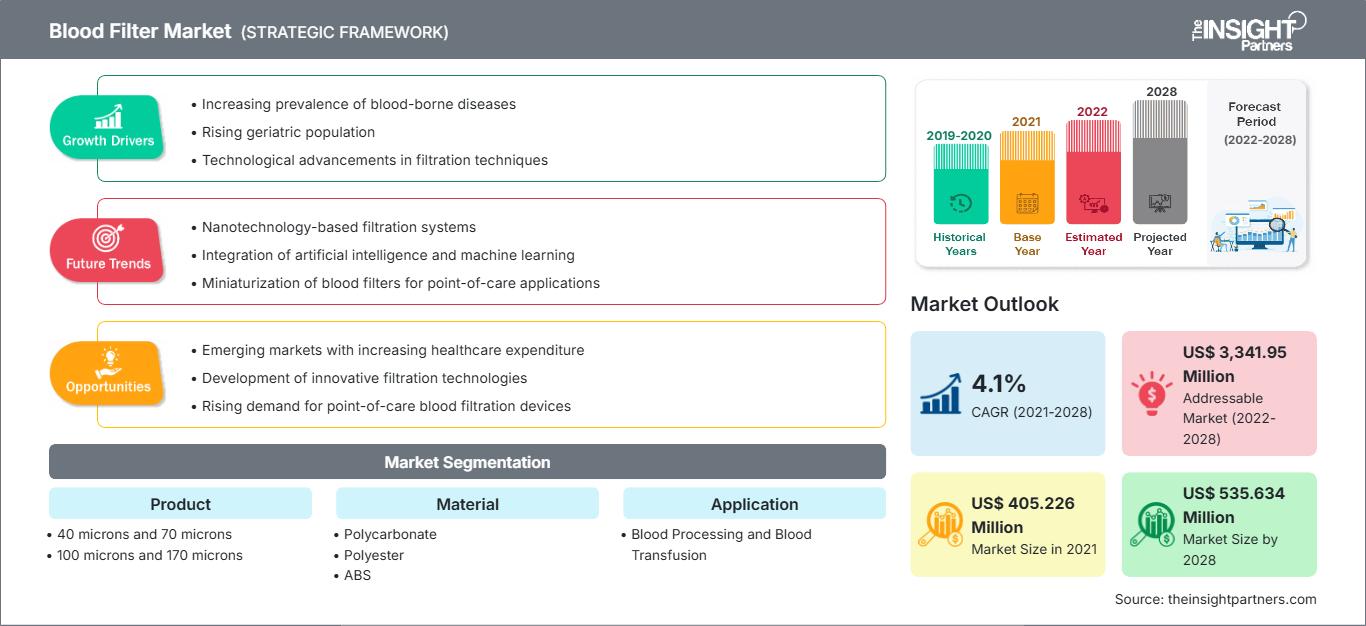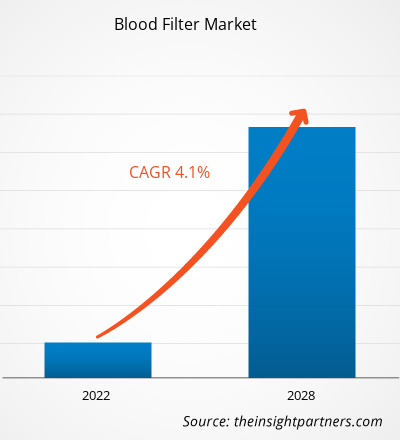预计到 2028 年,血液过滤器市场规模将从 2021 年的 4.05226 亿美元增至 5.35634 亿美元;预计 2021 年至 2028 年的复合年增长率为 4.1%。
血液过滤器是一种由聚酯或尼龙编织网组成的筛网式过滤器,放置在产品袋和患者之间进行过滤。这些过滤器旨在保护患者免受大聚集体和非血液成分颗粒物的侵害,这些物质如果进入血液可能有害。它们可以在输血过程中去除大聚集体,例如微聚集体位点和纤维蛋白聚集体。过滤包括捕获血液储存过程中形成的由白细胞、纤维蛋白和血小板组成的颗粒和大聚集体。慢性病负担加重、创伤和事故数量激增以及输血程序数量增加等因素推动了血液过滤器市场的增长。然而,产品召回事件阻碍了市场的增长。
自定义此报告以满足您的要求
您将免费获得任何报告的定制,包括本报告的部分内容,或国家级分析、Excel 数据包,以及为初创企业和大学提供超值优惠和折扣
血液过滤器市场: 战略洞察

-
获取本报告的主要市场趋势。这个免费样本将包括数据分析,从市场趋势到估计和预测。
市场洞察
输血程序数量的增加促进了血液过滤器市场的增长
改善输血程序所需的安全和充足血液的供应应成为每个国家的国家医疗保健政策和基础设施不可或缺的一部分。城市和农村地区随时都可能出现输血需求。过去,血液供应不足导致许多患者因疾病而死亡。通过为定期、自愿和无偿献血者提供稳定的设施,可以确保充足可靠的安全血液供应。他们也是最安全的献血者群体,因为这些献血者中血源性感染的患病率最低。
最常见的需要输血的手术包括心血管手术、剖腹产手术和损伤。根据美国国家心肺血液研究所和美国国立卫生研究院 (NIH) 的估计,美国每年有超过 500 万人需要输血。此外,由于自然灾害和广泛的人员伤亡,世界各地的输血需求都在增加。贫血、红细胞增多症、白细胞增多症、白细胞减少症和血小板增多症等血液疾病发病率的激增也推动了血液过滤器市场的增长。根据世界卫生组织的数据,大多数地中海贫血儿童出生在低收入国家,这些国家难以获得输血或只有一小部分人口可以获得输血。
输血过程中使用的血液过滤器是由聚酯或尼龙制成的编织网;这些是放置在产品袋和患者之间的筛网式过滤器。这些过滤器旨在保护患者免受潜在有害大聚集物(例如血小板、白细胞、纤维蛋白以及非血液成分颗粒物)的侵害。在大多数发达国家,输血过滤器由政府或社区项目提供。因此,合适的献血设施和自愿献血者的普及推动了输血程序的数量,从而促进了血液填充剂市场的增长。
基于产品的洞察
根据产品,血液过滤器市场进一步细分为 40 微米和 70 微米、100 微米和 170 微米以及其他规格。100 微米和 170 微米细分市场将在 2021 年占据最大市场份额,预计在预测期内将实现更高的复合年增长率。
基于材料的洞察
根据材料,血液过滤器市场细分为聚碳酸酯、聚酯、ABS 和其他材料。聚酯细分市场将在 2021 年占据 35.47% 的最大市场份额,预计在预测期内仍将保持主导地位。
基于应用的洞察
根据应用,血液过滤器市场细分为血液处理和输血。输血细分市场将在 2021 年占据 73.83% 的最大市场份额,预计在预测期内仍将保持主导地位。
基于最终用户的洞察
根据最终用户,血液过滤器市场细分为血库、医院和其他。血库市场将在 2021 年占据最大的市场份额,达到 47.38%,预计在预测期内仍将保持主导地位。
在血液过滤器市场运营的各类公司正在采取产品发布、并购、合作、产品创新和产品组合扩展等策略,以扩大其全球影响力、维护品牌知名度并满足最终用户日益增长的需求。
血液过滤器市场
The Insight Partners 的分析师已详尽阐述了预测期内影响血液过滤器市场的区域趋势和因素。本节还讨论了北美、欧洲、亚太地区、中东和非洲以及南美和中美洲的血液过滤器市场细分和地域分布。
血液过滤器市场报告范围
| 报告属性 | 细节 |
|---|---|
| 市场规模 2021 | US$ 405.226 Million |
| 市场规模 2028 | US$ 535.634 Million |
| 全球复合年增长率 (2021 - 2028) | 4.1% |
| 历史数据 | 2019-2020 |
| 预测期 | 2022-2028 |
| 涵盖的领域 |
By 产品
|
| 覆盖地区和国家 |
北美
|
| 市场领导者和主要公司简介 |
|
血液过滤器市场参与者密度:了解其对业务动态的影响
血液过滤器市场正在快速增长,这得益于终端用户需求的不断增长,而这些需求的驱动因素包括消费者偏好的不断变化、技术进步以及对产品优势的认知度不断提高。随着需求的增长,企业正在扩展产品线,不断创新以满足消费者需求,并抓住新兴趋势,从而进一步推动市场增长。

- 获取 血液过滤器市场 主要参与者概述
血液过滤器市场 — 按产品
- 40 微米和 70 微米
- 100 微米和 170 微米
- 其他
血液过滤器市场 — 按材料
- 聚碳酸酯
- 聚酯
- ABS
- 其他
血液过滤器市场 — 按应用
- 血液处理
- 输血
血液过滤器市场 —按最终用户划分
- 血库
- 医院
- 其他
血液过滤器市场 -按地理位置
- 北美
- 美国
- 加拿大
- 墨西哥
- 欧洲
- 法国
- 德国
- 意大利
- 英国
- 西班牙
- 其他地区欧洲
- 亚太地区(APAC)
- 中国
- 印度
- 韩国
- 日本
- 澳大利亚
- 亚太地区其他地区
- 中东和中东地区非洲 (MEA)
- 南非
- 沙特阿拉伯
- 阿联酋
- 中东和非洲其他地区
- 南美洲和中美洲其他地区
公司简介
- 旭化成株式会社
- 费森尤斯卡比股份公司
- Macopharma
- Haemonetics Corporation
- Infomed SA
- KANEKA CORPORATION
- 川澄制药有限公司
- 赛发股份公司
- 山东中宝康医疗器械有限公司
- 南京双威生物科技有限公司
- 历史分析(2 年)、基准年、预测(7 年)及复合年增长率
- PEST和SWOT分析
- 市场规模、价值/数量 - 全球、区域、国家
- 行业和竞争格局
- Excel 数据集
近期报告
相关报告
客户评价
购买理由
- 明智的决策
- 了解市场动态
- 竞争分析
- 客户洞察
- 市场预测
- 风险规避
- 战略规划
- 投资论证
- 识别新兴市场
- 优化营销策略
- 提升运营效率
- 顺应监管趋势






















 获取免费样品 - 血液过滤器市场
获取免费样品 - 血液过滤器市场